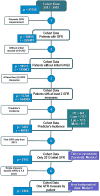Predicting chronic kidney disease progression with artificial intelligence
- PMID: 38671349
- PMCID: PMC11055348
- DOI: 10.1186/s12882-024-03545-7
Predicting chronic kidney disease progression with artificial intelligence
Abstract
Background: The use of tools that allow estimation of the probability of progression of chronic kidney disease (CKD) to advanced stages has not yet achieved significant practical importance in clinical setting. This study aimed to develop and validate a machine learning-based model for predicting the need for renal replacement therapy (RRT) and disease progression for patients with stage 3-5 CKD.
Methods: This was a retrospective, closed cohort, observational study. Patients with CKD affiliated with a private insurer with five-year follow-up data were selected. Demographic, clinical, and laboratory variables were included, and the models were developed based on machine learning methods. The outcomes were CKD progression, a significant decrease in the estimated glomerular filtration rate (eGFR), and the need for RRT.
Results: Three prediction models were developed-Model 1 (risk at 4.5 years, n = 1446) with a F1 of 0.82, 0.53, and 0.55 for RRT, stage progression, and reduction in the eGFR, respectively,- Model 2 (time- to-event, n = 2143) with a C-index of 0.89, 0.67, and 0.67 for RRT, stage progression, reduction in the eGFR, respectively, and Model 3 (reduced Model 2) with C-index = 0.68, 0.68 and 0.88, for RRT, stage progression, reduction in the eGFR, respectively.
Conclusion: The time-to-event model performed well in predicting the three outcomes of CKD progression at five years. This model can be useful for predicting the onset and time of occurrence of the outcomes of interest in the population with established CKD.
Keywords: Artificial intelligence; Machine learning; Prediction; Renal insufficiency; Renal replacement therapy.
© 2024. The Author(s).
Conflict of interest statement
All authors declare that they have no conflicts of interest.
Figures
References
-
- Lopera-Medina MM. Chronic kidney disease in Colombia: Health needs and response of the General System of Social Security for Health. Rev Gerenc Y Polit Salud. 2016;15:212–33. doi: 10.11144/Javeriana.rgyps15-30.ercc. - DOI
-
- Colombian Fund for High Cost Diseases -. High Cost Account (CAC); Situation for chronic kidney disease, arterial hypertension, and diabetes mellitus in Colombia 2022; Bogota D.C 2022. Published online 2023.
Publication types
MeSH terms
LinkOut - more resources
Full Text Sources
Medical
Research Materials
Miscellaneous




